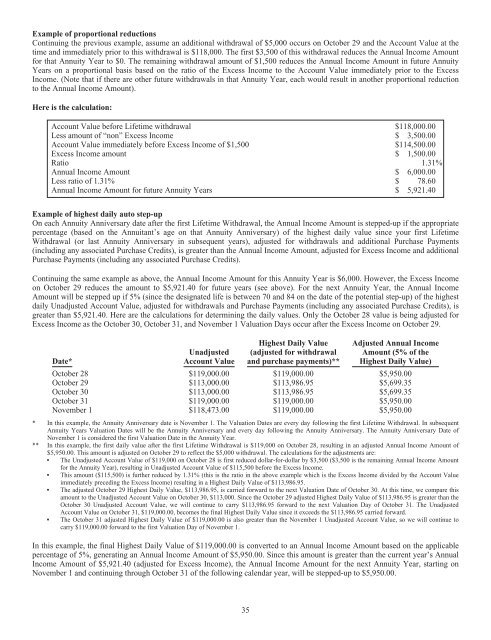Prudential Premier Retirement Variable Annuities
Prudential Premier Retirement Variable Annuities
Prudential Premier Retirement Variable Annuities
You also want an ePaper? Increase the reach of your titles
YUMPU automatically turns print PDFs into web optimized ePapers that Google loves.
Example of proportional reductions<br />
Continuing the previous example, assume an additional withdrawal of $5,000 occurs on October 29 and the Account Value at the<br />
time and immediately prior to this withdrawal is $118,000. The first $3,500 of this withdrawal reduces the Annual Income Amount<br />
for that Annuity Year to $0. The remaining withdrawal amount of $1,500 reduces the Annual Income Amount in future Annuity<br />
Years on a proportional basis based on the ratio of the Excess Income to the Account Value immediately prior to the Excess<br />
Income. (Note that if there are other future withdrawals in that Annuity Year, each would result in another proportional reduction<br />
to the Annual Income Amount).<br />
Here is the calculation:<br />
Account Value before Lifetime withdrawal $118,000.00<br />
Less amount of “non” Excess Income $ 3,500.00<br />
Account Value immediately before Excess Income of $1,500 $114,500.00<br />
Excess Income amount $ 1,500.00<br />
Ratio 1.31%<br />
Annual Income Amount $ 6,000.00<br />
Less ratio of 1.31% $ 78.60<br />
Annual Income Amount for future Annuity Years $ 5,921.40<br />
Example of highest daily auto step-up<br />
On each Annuity Anniversary date after the first Lifetime Withdrawal, the Annual Income Amount is stepped-up if the appropriate<br />
percentage (based on the Annuitant’s age on that Annuity Anniversary) of the highest daily value since your first Lifetime<br />
Withdrawal (or last Annuity Anniversary in subsequent years), adjusted for withdrawals and additional Purchase Payments<br />
(including any associated Purchase Credits), is greater than the Annual Income Amount, adjusted for Excess Income and additional<br />
Purchase Payments (including any associated Purchase Credits).<br />
Continuing the same example as above, the Annual Income Amount for this Annuity Year is $6,000. However, the Excess Income<br />
on October 29 reduces the amount to $5,921.40 for future years (see above). For the next Annuity Year, the Annual Income<br />
Amount will be stepped up if 5% (since the designated life is between 70 and 84 on the date of the potential step-up) of the highest<br />
daily Unadjusted Account Value, adjusted for withdrawals and Purchase Payments (including any associated Purchase Credits), is<br />
greater than $5,921.40. Here are the calculations for determining the daily values. Only the October 28 value is being adjusted for<br />
Excess Income as the October 30, October 31, and November 1 Valuation Days occur after the Excess Income on October 29.<br />
Date*<br />
Unadjusted<br />
Account Value<br />
Highest Daily Value<br />
(adjusted for withdrawal<br />
and purchase payments)**<br />
Adjusted Annual Income<br />
Amount (5% of the<br />
Highest Daily Value)<br />
October 28 $119,000.00 $119,000.00 $5,950.00<br />
October 29 $113,000.00 $113,986.95 $5,699.35<br />
October 30 $113,000.00 $113,986.95 $5,699.35<br />
October 31 $119,000.00 $119,000.00 $5,950.00<br />
November 1 $118,473.00 $119,000.00 $5,950.00<br />
* In this example, the Annuity Anniversary date is November 1. The Valuation Dates are every day following the first Lifetime Withdrawal. In subsequent<br />
Annuity Years Valuation Dates will be the Annuity Anniversary and every day following the Annuity Anniversary. The Annuity Anniversary Date of<br />
November 1 is considered the first Valuation Date in the Annuity Year.<br />
** In this example, the first daily value after the first Lifetime Withdrawal is $119,000 on October 28, resulting in an adjusted Annual Income Amount of<br />
$5,950.00. This amount is adjusted on October 29 to reflect the $5,000 withdrawal. The calculations for the adjustments are:<br />
▪ The Unadjusted Account Value of $119,000 on October 28 is first reduced dollar-for-dollar by $3,500 ($3,500 is the remaining Annual Income Amount<br />
for the Annuity Year), resulting in Unadjusted Account Value of $115,500 before the Excess Income.<br />
▪ This amount ($115,500) is further reduced by 1.31% (this is the ratio in the above example which is the Excess Income divided by the Account Value<br />
immediately preceding the Excess Income) resulting in a Highest Daily Value of $113,986.95.<br />
▪ The adjusted October 29 Highest Daily Value, $113,986.95, is carried forward to the next Valuation Date of October 30. At this time, we compare this<br />
amount to the Unadjusted Account Value on October 30, $113,000. Since the October 29 adjusted Highest Daily Value of $113,986.95 is greater than the<br />
October 30 Unadjusted Account Value, we will continue to carry $113,986.95 forward to the next Valuation Day of October 31. The Unadjusted<br />
Account Value on October 31, $119,000.00, becomes the final Highest Daily Value since it exceeds the $113,986.95 carried forward.<br />
▪ The October 31 adjusted Highest Daily Value of $119,000.00 is also greater than the November 1 Unadjusted Account Value, so we will continue to<br />
carry $119,000.00 forward to the first Valuation Day of November 1.<br />
In this example, the final Highest Daily Value of $119,000.00 is converted to an Annual Income Amount based on the applicable<br />
percentage of 5%, generating an Annual Income Amount of $5,950.00. Since this amount is greater than the current year’s Annual<br />
Income Amount of $5,921.40 (adjusted for Excess Income), the Annual Income Amount for the next Annuity Year, starting on<br />
November 1 and continuing through October 31 of the following calendar year, will be stepped-up to $5,950.00.<br />
35

















